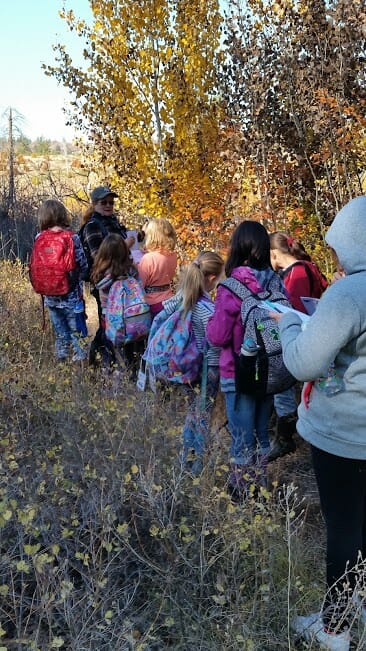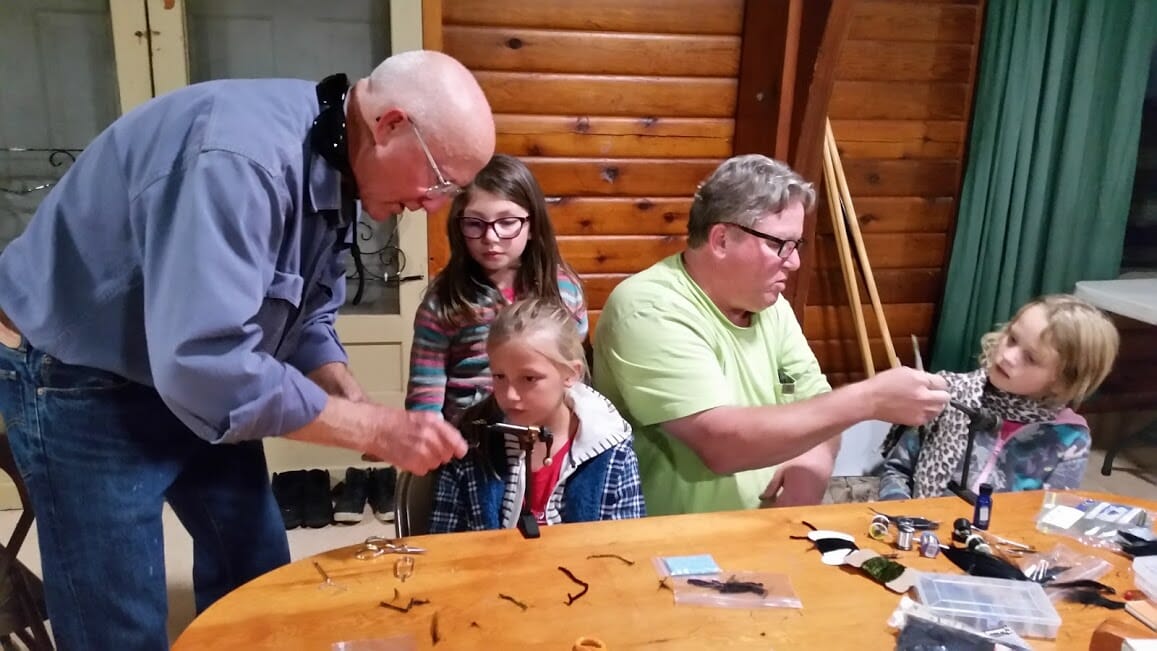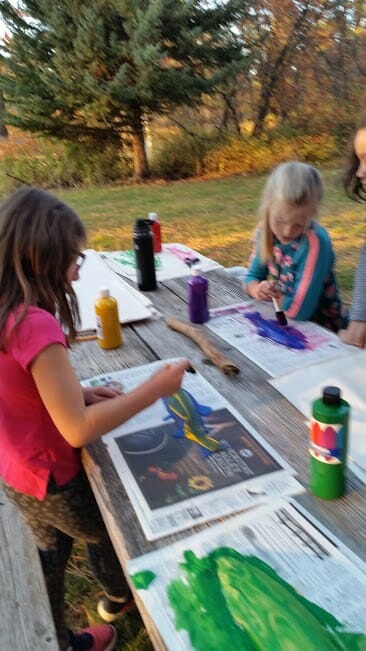The brilliant autumn colors along the riparian area at Brooks Memorial State Park provided the perfect backdrop for time in the stream. The East Prong of the Little Klickitat River flows over a mile right through this Washington State Park and travels 13 miles south through the town of Goldendale. It was a beautiful fall weekend for our first STREAM (Science, Technology, Recreation, Engineering, Art, and Math) Explorers camp hosted by the Klickitat Chapter #484 of Trout Unlimited.
The explorers in grades 4-6 began arriving Friday evening with sleeping bags, outdoor gear, and a sense of adventure. As Trout Unlimited is a cold water conservation, protection, and restoration organizations, this was a perfect opportunity for youth. Thanks to grants from the Trout Unlimited Washington State Council and the National Trout Unlimited Embrace a Stream program, our STREAM Explorers camp was coming alive. With donations from both businesses, mentors, and our own TU chapter members, the $25 fee for an entire weekend of food, lodging, and fishing lessons became possible for these 26 students. Scholarships were offered for those who applied so that all who wished to could attend camp. The students were about to see a stream like they never had before!

As parents dropped off their campers and helped them settle into the heated cabins at Brooks, the volunteer TU member mentors D’Ann Horrocks, Lisa Baranek, and Laurie Wilhite greeted them offering name tags, STREAM Explorers guides, and art projects in the lodge. These three had learned how to facilitate this special camp from Franklin Tate—TU author of the math and science-based curriculum, Brad Throssell—Washington State TU President, and Melissa Graeper—Northwest TU Volunteer Coordinator, and others at previous camps this year. It was dark outside at the registration table by the time the last camper arrived, but there was warmth and energy building inside the historic knotty pine lodge.
The idea of offering a STREAM Explorers camp to Klickitat County youth started over a year ago. It was the work of our local TU chapter’s youth engagement committee that worked together with the local board to successfully request the funding that made this project possible. Fund raising efforts by chapter members also helped make the project happen. The mentors, explorers, and some parents were all gathered in the lodge and were asked to—Think Like a Fish!
A healthy stream has nine identifiable elements. Our explorers sat at nine round tables representing each of these elements as the concepts were introduced. Each table had a poster identifying an element. TU mentor leader Horrocks and her stuffed rainbow trout (stuffed toy) circulated around the room encouraging students at each table to share why each element: water, riffles, rocks, trees, wood (logs), short plants, sky, animals, and bugs is key to a healthy stream. It was time for action as TU mentor leader Wilhite asked the group, “Please take what you have learned and now think like a fish on a very hot, sunny day!” Explorers rapidly grouped at the trees table so they could find shade. “Where would a fish go if they wanted protection from predators?,” asked Wilhite. Eager feet pounded the lodge floor as campers ran to the logs table. The active learning game continued with several more rounds before it became obvious that campers were indeed thinking like a fish, perhaps for the first time in their lives. After a snack, it was off to the cabins and bed as Saturday was a busy day.
The next morning, the smell of bacon, eggs, and pancakes prepared by volunteer cooks Jessie Steele, Mary Huber, and Betty McKune caught the attention of the campers as they entered the lodge. Camp food can be one of most memorable parts of the experience, and there was an abundance of opportunity to fuel the bodies of the campers and mentors with traditional menu items.
The first adventure of the day was to complete an hour-long stream walk in two separate sections of the Klickitat River at Brooks. Explorers at camp were asked to look at the stream as a scientist, an artist, and an angler in hopes that they would learn something new about the watershed in which we live. Key elements of Tate’s hands-on curriculum include this exploratory walk in the riparian area to research the health of the stream, macroinvertebrate sampling, fly casting, fly tying, and the nine ingredients of a healthy stream. Signs of wildlife and human activity were recorded in STREAM guides as students walked the Little Klickitat River. Explorers easily found these nine elements of a healthy stream. Reflections written in STREAM guides regarding what the student scientists were learning were shared at various times throughout the weekend camp.
Volunteerism is a natural part of Trout Unlimited’s connection to sharing conservation and recreation opportunities with youth. Klickitat TU Chapter #484 is a small organization in numbers, but large in the commitment of members to volunteer their time for youth. Tom Fritsch started the local chapter some 25 years ago and has continued to be active in the organization. He was at Brooks to teach kids how to cast a rod as well as how to tie a fly. Other chapter members including Dick Stentz, Keith Steele, Greg Short, and Bob Dunn were also on hand to help teach the afternoon casting sessions. Explorers cast their rods into hula hoops to perfect their aim and learned a variety of casting techniques. Former Klickitat Trout Unlimited President, Olivia Holderman, volunteered her photography skills to capture the memories made at camp.

While half of the campers were improving their casting skills, the other half were researching the presence of macroinvertebrates in the stream. The two groups switched pursuits midafternoon. Time to play in the stream proved to be great fun as well as a revelation of what lies beneath the river rock. Stonefly, caddis, larvae worms, and even a crawdad presented themselves from under rocks for closer investigation. Once brought up from the stream in buckets, the macroinvertebrates were isolated into ice cube trays and magnifying lenses were used to identify body parts. The number of legs, body shape, and tails were all used as clues to find the name of the bug. Understanding what fish like to eat not only makes an effective angler, but also identifies the elements of a healthy habitat for fish.
The afternoon also provided time for students to explore art projects. The art portion of the STREAM curriculum included sketching the riparian area and macroinvertebrate bugs that the explorers found in the stream. Explorers also had the opportunity to create fish prints using paint and rubber molds of salmon. The nature art leathercraft station and lessons helped campers create book marks, key chains, coasters, and wristbands to take home. Leather stamps used included icons of trout, dragonfly, eagle, forest, deer, butterfly, and even alphabet letters for monograming the artwork. During this time other recreation opportunities included tether ball, football, hiking, and sand volleyball. Brooks is located on 700 acres and has an abundance of recreational opportunities for adults and youth.
 Reflection of the day’s adventures took place in the lodge just before dinner. Explorers reviewed and recorded what they had observed during the day in their STREAM Explorers guides. As the campers devoured the dinner, they were reminded of the evening’s highlight…other than S’mores. They were going to learn to tie a fly to take home and try fishing with in an area lake or river. Local TU chapters members Tom Fritsch, Dick Stentz, Greg Short, and Keith Steele set up a fly tying station in the lodge and shared their expertise with the STREAM Explorers. Most students had never seen a fly tied before, and after Fritsch’s demonstration many of them got a turn making a fly at the vise. While some were tying flies, others stepped outside with Planisphere’s to interpret the dark skies at Brooks. Lack of population density at this retreat on Highway 97 heading to Yakima creates a rare treat for night sky viewing. Campers easily located Cassopeia, Ursa Major, and Mars, but were challenged to find the Pegasus and other constellations.
Reflection of the day’s adventures took place in the lodge just before dinner. Explorers reviewed and recorded what they had observed during the day in their STREAM Explorers guides. As the campers devoured the dinner, they were reminded of the evening’s highlight…other than S’mores. They were going to learn to tie a fly to take home and try fishing with in an area lake or river. Local TU chapters members Tom Fritsch, Dick Stentz, Greg Short, and Keith Steele set up a fly tying station in the lodge and shared their expertise with the STREAM Explorers. Most students had never seen a fly tied before, and after Fritsch’s demonstration many of them got a turn making a fly at the vise. While some were tying flies, others stepped outside with Planisphere’s to interpret the dark skies at Brooks. Lack of population density at this retreat on Highway 97 heading to Yakima creates a rare treat for night sky viewing. Campers easily located Cassopeia, Ursa Major, and Mars, but were challenged to find the Pegasus and other constellations.
It became clear to all present that thinking like a fish is important for recreation and supporting conservation efforts. Weary campers enjoyed a dessert of ice cream sundaes and s’mores before heading to the sleeping quarters. It had been a very long day, but some campers commented that they never wanted it to end. Some had never been to a camp of any kind before, and one camper told Wilhite, “I just want this to never end, I want to live here!”
The closing ceremony Sunday morning reviewed the nine elements of a healthy stream. Each camper was given a bead representing those nine elements and strung them together to make a key chain. The youth helped to clean up and check out of the cabins and lodge as parent showed up to collect their campers. An optional tour of the Trout Hatchery in Goldendale was arranged for the group as fishing conditions at area lakes had dwindled. The first ever STREAM Explorers camp for our Klickitat Chapter #484 of Trout Unlimited was over. Memories had been made, lessons were learned, new ideas had formed, and friendships were strengthened. We all learned from the stream.
Blog by Laurie Wilhite



